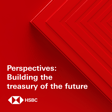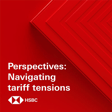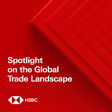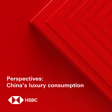Become a Creator today!Start creating today - Share your story with the world!
Start for free
00:00:00
00:00:01

In conversation with business leaders in Asia: Supply chain resiliency in consumer and retail – Part 1
Gain insights from business leaders in the consumer and retail sector on how they have navigated disruptions in their supply chains, and how they expect supply chains to evolve against the backdrop of the global pandemic.
In Part 1, HSBC and Deloitte Consulting speak with Fonterra, Kimberly-Clark, and Cargill to discuss the impact on industry and consumer purchasing behavior, shifts in company operating models, and how they have maneuvered the crisis.
This conversation was recorded in August 2020.
For more information about anything that you have heard in this podcast, please visit grp.hsbc/cr
Hosted on Acast. See acast.com/privacy for more information.
Transcript
Introduction and Overview
00:00:00
Speaker
This is HSBC Global Viewpoint, your window into the thinking, trends and issues shaping global banking and markets.
00:00:09
Speaker
Join us as we hear from industry leaders and HSBC experts on the latest insights and opportunities for your business.
00:00:18
Speaker
A heads up to our listeners that this episode has been recorded remotely, therefore the sound quality may vary.
00:00:23
Speaker
Thank you for listening.
Introduction to Supply Chain Resilience Session
00:00:29
Speaker
Welcome to In Conversation with Business Leaders in Asia, jointly organized by Beloyed Consulting and HSBC.
00:00:36
Speaker
Today's topic, supply chain resilience in consumer and retail.
00:00:41
Speaker
My name is Winfield Wong, representing HSBC, and I am the Regional Head of Business Development for Asia-Pacific Global Trade and Receivables Finance.
00:00:50
Speaker
I will be your moderator for this session.
00:00:52
Speaker
Joining me as facilitator is Mr. Boyd Kester, a partner in Deloitte Consulting Singapore.
00:00:59
Speaker
So, Boyd, over to you to introduce yourself.
00:01:01
Speaker
Yeah, thank you Winful.
00:01:03
Speaker
As you mentioned, my name is Boy Kester.
00:01:05
Speaker
I'm originally from the Netherlands, but based here in Singapore, looking after growth for our clients in the consumer industries, both organic, but also inorganic growth.
00:01:15
Speaker
And in that vicinity, I also lead the regional M&A consulting team.
00:01:22
Speaker
And today I will be, apart from being your sidekick Winfield, I will also be sharing a few industry insights from our recurring industry research, as well as typically what we're running into with our clients in the consumer industries space.
00:01:39
Speaker
Thank you, Boyd.
Economic Performance and Consumer Retail
00:01:40
Speaker
And there is a strong link between consumer retail industry and the underlying economic performance of each country.
00:01:46
Speaker
That's why.
00:01:48
Speaker
This industry is so closely watched by industrialists, economists, financial professionals, especially during this period as we navigate through the demand side and supply side shocks caused by COVID-19.
00:02:00
Speaker
Today, we will be spending the next 30 minutes on the subject of recovering the business during COVID.
00:02:08
Speaker
Now, you can expect an interesting exchange of views on how customers' behaviors evolved and how business operating models altered.
00:02:17
Speaker
So now speaking of the professionals and industry experts, we're extremely privileged to have three distinguished guests joining us in our panel discussion.
00:02:28
Speaker
Allow me to introduce first, Mr. Approve Gupta, Head of Procurement Asia Pacific, Kimberly Clark.
00:02:35
Speaker
Next, we have Mr. Hamjan Maja, Head of Sourcing and Procurement for Asia Pacific, Targill.
00:02:41
Speaker
Last but not least, we have Mr. Amya Mahi,
00:02:44
Speaker
Director of Supply Chain for Fonterra.
00:02:47
Speaker
Now, without further ado, let's jump straight into our first topic, recovering the business during COVID-19, where we will hear from the experts on how customers' behavior changes, impact on operating models, and responses to supply chain disruption.
00:03:06
Speaker
So, Boyd, would you like to help us set the scene
00:03:10
Speaker
by sharing with us what Deloitte sees across the consumer sector across Asia-Pacific.
00:03:16
Speaker
Over to you.
Consumer Spending Shifts During COVID-19
00:03:18
Speaker
Thank you, Wienfield.
00:03:19
Speaker
So the insights I'm going to share with you are based on a recurring bi-weekly survey that we started in April this year.
00:03:27
Speaker
In this survey, it's called the Deloitte State of the Consumer Tracker, and it's freely available also via Deloitte.com.
00:03:33
Speaker
But we've been surveying people about how they feel, how they feel about their health, how they feel about their financial situation.
00:03:43
Speaker
and what they are intending to do when it comes to spending money in the foreseeable future.
00:03:49
Speaker
So for the forthcoming four weeks.
00:03:51
Speaker
And because we've been doing this every two weeks since April, going into August, you can really see a clear trend between the various markets and how it affects the, basically how it,
00:04:03
Speaker
captures the state of mind of the people that we're surveying.
00:04:07
Speaker
Now, one very interesting thing is because COVID has been around for a couple of months now, and we're starting to settle into this kind of like new normal, and maybe, and nobody has the answer, COVID is gonna be around for a little while longer.
00:04:22
Speaker
We are starting to see in the data that people are getting less concerned about their financial state of affairs.
00:04:31
Speaker
Now, you will see that this does not necessarily lead towards a change in spending intent.
00:04:40
Speaker
So we survey people in a variety of categories from alcohol to apparel, but also just basic household goods or restaurant takeout.
00:04:50
Speaker
Are they changing their intention to spend money?
00:04:56
Speaker
And for example, at the start of the lockdowns, you could see that people were actually spending money on electronics because they had to start working from home.
00:05:04
Speaker
So they were investing money in buying a display or a second display even, or computer peripherals such as a mouse or a keyboard or a speakerphone.
00:05:15
Speaker
But now that those purchases have been made, you actually see that the intention to spend money in that particular space is going down.
00:05:25
Speaker
Now, one of the other things that was very interesting to see in the data, and again, we're just showing a snapshot here.
00:05:30
Speaker
There is a wealth of domains being investigated, also around mobility or intent to travel and those kind of things.
00:05:39
Speaker
But there's also something about consumer personas.
00:05:42
Speaker
And one of the things that really jumped at me in the data is that people are actually starting to
00:05:50
Speaker
divert their money towards socially conscious companies, meaning they are actually choosing and preferring players in the market space that dealt well with COVID.
00:06:04
Speaker
And a little later in the panel conversation, we will actually go into that because this is for me, one of the key things that COVID is actually brought to surface.
00:06:14
Speaker
that we're in this together.
00:06:16
Speaker
And ultimately, those that are looking out for one another are actually slowly becoming the winners in the various segments that they play.
00:06:25
Speaker
Winful, over to you.
00:06:26
Speaker
Thanks, Boy.
00:06:27
Speaker
Really interesting points that consumers are still focused on essential items only.
00:06:32
Speaker
All of us should be really keen to understand more about how purchasing behaviors change and the corresponding impacts on business.
00:06:39
Speaker
So let's start with
00:06:41
Speaker
the basics, right?
00:06:43
Speaker
So Hamjan, over to you.
Changes in Retail and E-commerce
00:06:45
Speaker
Would you like to share about what is the impact on the agri industry and your customers purchasing behavior?
00:06:55
Speaker
Yours.
00:06:56
Speaker
Yes, thank you, Winfield.
00:06:57
Speaker
And by the way, thank you for having us this afternoon.
00:07:00
Speaker
Customer purchasing behavior in the food sector did change.
00:07:05
Speaker
And one of the things that stands out to me is basically the channel shift between the restaurant channel as well as the retail channel.
00:07:13
Speaker
I mean, McDonald's is a really large customer for Cargill and seeing McDonald's closing its restaurants is not something that we often see.
00:07:23
Speaker
So that was a big impact to that channel.
00:07:26
Speaker
And then secondly, getting pictures from all over the world of empty shelves in supermarkets is also something that is quite rare in many countries.
00:07:37
Speaker
So definitely consumer or customer purchasing behavior has changed.
00:07:42
Speaker
And I do think that now somewhat of a new normal has set in.
00:07:48
Speaker
Things have normalized and the supply chain has shown resilience.
00:07:52
Speaker
It's very interesting, Hamir, that you touched on a point about supermarkets and the other thing that really interests me and associated with supermarkets is actually personal care.
00:08:01
Speaker
Now, my next question is approval.
00:08:04
Speaker
What about personal care segment and have the purchasing behaviors for end customers actually changed?
00:08:10
Speaker
And more importantly,
00:08:12
Speaker
Given that you may be dealing with what I call intermediaries and corporates such as distributors and retailers, has the experience been different under COVID situation?
00:08:24
Speaker
Yours.
00:08:26
Speaker
Thank you so much for the opportunity to participate in this panel.
00:08:30
Speaker
A fantastic piece of data which we just saw.
00:08:34
Speaker
There has been a tremendous amount of change which we have seen in the
00:08:38
Speaker
first half of 2020.
00:08:40
Speaker
It's been an unusual period of time.
00:08:43
Speaker
Fortunately, Kimberly Clark goods are classified as essential goods.
00:08:47
Speaker
Essential goods have seen a very significant growth in this period.
00:08:54
Speaker
What we've seen is a very big difference in the behavior of our customers and our consumers in terms of their buying patterns.
00:09:03
Speaker
So we've seen a significant increase in e-commerce adoption
00:09:08
Speaker
And just a very interesting statistics, the amount of growth we saw in the e-commerce penetration in six months of 2020 is equal to the accumulated growth we saw in the last 10 years.
00:09:21
Speaker
So that's how much e-commerce has grown.
00:09:23
Speaker
And as a result, all our key customers like Tesco, Fairprice, Kohl's, you name it, a lot of them have immediately focused a lot on the e-commerce channel.
00:09:34
Speaker
And from our consumer side, the people who actually use the products, they have really adopted and embraced the e-commerce channel to buy a product.
00:09:43
Speaker
So what does that mean for us?
00:09:45
Speaker
We've had to look at the range of products we offer.
00:09:49
Speaker
We've had to make it more amenable to the e-commerce channel.
00:09:54
Speaker
Customers are exposed to now a lot more choices because when they go onto the internet, they see they can access products and ranges and
00:10:02
Speaker
brands which they probably may not have had access to in a normal retail format.
00:10:08
Speaker
And there has been a huge change which supply chains have had to make and investment supply chains have had to make to cater to this new growth of the e-commerce channel and being able to replenish to the consumers using e-commerce.
00:10:24
Speaker
So that has been, I would say, the one major biggest difference or key change in the personal care category.
00:10:31
Speaker
I really like your point about e-commerce and I really want to come back to this point about change at a later stage as well.
00:10:38
Speaker
But meantime, I want to go back to Boy's point on how essential items remains main driver for consumer spending.
00:10:47
Speaker
So my next question is actually to Amir from Fontera.
Dairy Industry and Business Model Changes
00:10:50
Speaker
Now, given that Fontera accounts for more than 30% of the world's dairy products, I am curious to hear
00:10:58
Speaker
that if you see a similar shift in purchasing behavior from consumers?
00:11:02
Speaker
Yeah, Winfield, thank you very much again for the opportunity to participate in this roundtable.
00:11:06
Speaker
I just want to make a quick small correction.
00:11:08
Speaker
I think the 30% number is via the 30% export of the world's market.
00:11:12
Speaker
Nevertheless, it is a very big number.
00:11:14
Speaker
New Zealand is a small country.
00:11:15
Speaker
It punches above its weight.
00:11:16
Speaker
And dairy is one of the main primary industries.
00:11:19
Speaker
that we're proud of taking out to the world.
00:11:22
Speaker
I would second what Apoorva, Hamyan, and Envoy has shared with us so far.
00:11:26
Speaker
I mean, you could debate the numbers plus minus a little bit, but definitely the purchasing trends have shifted, whether you're talking channel or in our case, because we are both a B2C and a B2B player, we actually have experienced both ends of the extremities.
00:11:43
Speaker
On the out-of-home sector, as Hamyan talked about,
00:11:46
Speaker
People either could not or would not go and eat outside their homes.
00:11:50
Speaker
So, you know, our food service experience is not so positive when it comes to demand.
00:11:54
Speaker
The whole industry, tourism, aviation, hospitality is suffering, as we all observe.
00:11:58
Speaker
And on the other side, in the early days of COVID, we saw a lot of panic buying, a lot of pantry loading that consumers did.
00:12:04
Speaker
Whether it was through e-commerce or whether it was talking of e-commerce, you would be seeing them running out of delivery slots even in four or five days of wait while they could deliver the same day earlier.
00:12:17
Speaker
And so we have to deal with the bullwhip effect as well.
00:12:20
Speaker
And since we are a vertically integrated end-to-end daily company, it is not easy to just overnight shift or cater to such a big shift.
00:12:28
Speaker
Of course, everybody thought in the beginning that people are panicking, they're loading their pantries, it's going to come down, the bullwhip is going to stabilize, and you plan for that.
00:12:37
Speaker
But then you observe that as people have to stay for longer and longer at home, they start making some other interesting choices.
00:12:44
Speaker
What they would normally buy from a bakery, they would start baking at home.
00:12:49
Speaker
If they're staying all day, 24 hours with the family at home in lockdowns, you tend to consume more.
00:12:54
Speaker
The kids tend to snack more.
00:12:56
Speaker
So really that deloading, the unloading doesn't necessarily happen.
00:13:01
Speaker
And as everyone is planning in a crisis business continuity mode, nobody predicted this would be a years long kind of crisis.
00:13:08
Speaker
I think the nature of the reaction has been a little bit different.
00:13:12
Speaker
We are all trying to keep up as supply chain.
00:13:13
Speaker
I think you are in the front line of the first response that companies have to make to adapt to this.
00:13:20
Speaker
So I would say, yes, absolutely.
00:13:22
Speaker
We've experienced and I can confirm that the data that Deloitte is sharing is definitely capturing a megatrend, which is true and here to stay for a while.
00:13:31
Speaker
Very interesting points on consumer behaviors, but I'm going to shift to talk about your business models.
00:13:39
Speaker
And in HSBC, actually, we conducted a survey of over 2,600 businesses across 14 countries and markets and territories between April and May.
00:13:50
Speaker
We call that navigator survey.
00:13:52
Speaker
So interestingly, 98% of the responses said that they have been impacted by COVID.
00:13:59
Speaker
Now, in fact, the COVID-19 crisis is forcing many businesses to adapt
00:14:04
Speaker
Rapid change has taken place in a condensed time scale with more than three in five firms making adaptations.
00:14:12
Speaker
Now, only 26% of the business reported operating as normal.
00:14:20
Speaker
Now, so with a global shift in demand and supply of goods and services, business and procurement strategies should evolve to adapt.
00:14:30
Speaker
So let me first ask Approve, have you seen a significant change in operating model of your company as a result of the pandemic?
00:14:41
Speaker
What areas of your business are more impacted vis-a-vis others?
00:14:47
Speaker
Approve, over to you.
00:14:50
Speaker
Thank you very much.
00:14:51
Speaker
So great point made by Aamir about the panic buys and the pantry loading.
00:14:56
Speaker
So the kind of products Kimberly Clark makes, hand sanitizers, masks,
00:15:01
Speaker
diapers, sanitary care tissues.
00:15:04
Speaker
These were exactly the kind of goods which were facing this panic buying and this pantry loading.
00:15:10
Speaker
And what we saw was several things in this whole chain.
00:15:13
Speaker
So we have small suppliers and big suppliers.
00:15:16
Speaker
And a lot of our big suppliers were able to weather the change and the limitations of during the lockdown.
00:15:23
Speaker
But a lot of our small suppliers required a lot of hand-holding.
00:15:27
Speaker
And we had to really focus on
00:15:30
Speaker
vendor due diligence for those suppliers to make sure that their supply chains are robust.
00:15:35
Speaker
They've got BCP plans, business continuity plans for their feedstocks.
00:15:40
Speaker
They have enough cash to keep their business running.
00:15:43
Speaker
And then, you know, they're able to get all the right support required to keep operating.
00:15:50
Speaker
We had to do a lot of business continuity planning internally as well.
00:15:54
Speaker
And we relied a lot on data analytics to really move to a predictive modeling on how we identify exceptions and how do we manage those exceptions before they become a major disruptor in our supply chain.
00:16:07
Speaker
That led to a requirement for a lot of end-to-end visibility of the supply chain and integration both with our suppliers as well as our customers.
00:16:16
Speaker
And it unlocked a lot of digitization-related programs, which were kind of on a back burner and may have seen the light of day maybe a few months or a few years down the line.
00:16:29
Speaker
All those all of a sudden became priority projects.
00:16:31
Speaker
And we started to see a lot of movement on digitization.
00:16:35
Speaker
There was a lot of focus on resilience of our whole supply chain as well.
00:16:39
Speaker
And in addition to that, we had to play a huge role in our corporate social responsibility because there were a lot of consumers who really needed our products, but either could not access them or, you know, maybe in some cases could not afford them.
00:16:54
Speaker
So we had to look at how do we cater to all our consumers, both ones who have access to our products and those who don't.
00:17:01
Speaker
And how do we make sure that we manage the whole COVID-19 situation in a very responsible corporate way?
00:17:10
Speaker
So these were some of the major changes we saw in the first half of 2020.
00:17:14
Speaker
Oh, thanks.
00:17:15
Speaker
Thanks, Aruv.
00:17:16
Speaker
Good points.
00:17:16
Speaker
I mean, what I could hear is that there are suppliers and there are suppliers as well.
00:17:21
Speaker
And you have equations such as working capital that comes into play as well.
00:17:25
Speaker
And this brings me nicely to a next point on risk management.
00:17:30
Speaker
Ham Yan,
Localization vs Global Strategies
00:17:31
Speaker
over to you.
00:17:31
Speaker
There has been a lot of talk about decentralization of supply chains as a result of the pandemic.
00:17:38
Speaker
Do you see
00:17:40
Speaker
the need to redefine regional versus global responsibilities and how will you strike that balance between costs and benefits of de-risking?
00:17:52
Speaker
Kamian, your views?
00:17:54
Speaker
Yes, Winfield.
00:17:55
Speaker
I think that's a really relevant question.
00:17:58
Speaker
And if I might comment just from a procurement lens, what we have seen in the last couple of years is that large multinationals are further and further centralizing procurement
00:18:09
Speaker
sending out business services, often offshoring activities.
00:18:14
Speaker
And it is in my mind, very interesting to realize that in times of a pandemic and for that matter, supply chain disruption, standard operating procedures such as we made in the past might not be sufficient anymore.
00:18:30
Speaker
What we have seen in this crisis is the importance of the on the ground response to supply challenges.
00:18:38
Speaker
And Apoorva referred to it, it's about business continuity plans, being able to work on the grounds locally with your businesses on such plans, defining what are the most critical items at any point in time, and then potentially developing local alternatives.
00:18:55
Speaker
So in my mind, what we are learning here is the importance of localization and regional teams.
00:19:02
Speaker
And yes, this might swing the pendulum a little bit back
00:19:06
Speaker
from doing things globally to doing things more regionally.
00:19:11
Speaker
The other element of your question, specifically on the element of vendor risk, and Apoor also commented on that, is also very relevant, I think.
00:19:18
Speaker
I think what we will see less is, for example, single sourcing.
00:19:22
Speaker
If we evaluate
00:19:24
Speaker
supply chain risk, we will probably be looking at a different weighing criteria in a different way, maybe focusing on supplier routes and on vendor production locations, for example, where in the past we were less worried about that.
00:19:40
Speaker
And yes, potentially this could even have a cost increase effect.
00:19:44
Speaker
So that's all very relevant.
00:19:45
Speaker
And I just want to add here, Winfield, it's also important to note that
00:19:50
Speaker
that what I just said in my view is not only a result of the pandemic or the crisis we are in, but it basically relates to everything that's happening in the world today with tariffs and trade war, for example.
00:20:05
Speaker
It's a very good point, Amir.
00:20:06
Speaker
I think it's a different role right now.
00:20:08
Speaker
But let's go back to the point on the changes in operating model.
00:20:13
Speaker
And from HSBC, I did mention about the navigator survey whereby three in five are making adaptations.
00:20:20
Speaker
So Amir, over to you, right?
00:20:23
Speaker
For Fontera, six months into the pandemic.
00:20:26
Speaker
And I guess the question is, is it time for you to incorporate resiliency and redundancy in your operating model?
00:20:36
Speaker
What are your thoughts?
00:20:39
Speaker
Absolutely, absolutely Winfield.
00:20:41
Speaker
I think one thing this pandemic has done is it has brought a positive spin to the terms of resiliency and redundancy.
00:20:49
Speaker
In normal times, resiliency is important.
00:20:52
Speaker
Nobody doubts or disagrees, but it's down below on your agenda when you discuss business plans and whatnot.
00:20:58
Speaker
And redundancy usually has a negative connotation attached to it, right?
00:21:02
Speaker
But what we are realizing is this being used as a supply chain strategy in the future.
00:21:07
Speaker
One thing, of course, everybody needs to be mindful of is we cannot now prepare for another COVID-19.
00:21:13
Speaker
Because if we do, we're going to fail miserably because the next crisis is definitely going to be something different.
00:21:18
Speaker
Having said that, in Fonterra, like any other company, there were business continuity plans.
00:21:23
Speaker
We did have decent redundancy in the system, so we can value it.
00:21:27
Speaker
But for me, I think the new direction of diversity, which so far we talk in the context of inclusion and organization,
00:21:35
Speaker
the diversity of your supplier base, which is probably what Hamian was alluding to earlier, has become very important.
00:21:39
Speaker
You know, when the crisis hit, everybody went to secure themselves ex-China because that's where the problem was.
00:21:45
Speaker
And of course, a big chunk of the world manufacturing sits in China.
00:21:49
Speaker
Nobody could have predicted in January that March, April, the pandemic would shift to the Western Hemisphere.
00:21:54
Speaker
And, you know, you were just caught once again in the same situation.
00:21:57
Speaker
So what's great is redundancy is being looked at.
00:22:00
Speaker
It has to be selective.
00:22:00
Speaker
It has to make business sense, absolutely.
00:22:03
Speaker
But I think it's still a little bit
00:22:04
Speaker
early for us to know what these mega trends will eventually settle down into.
00:22:09
Speaker
The new normal is still manifesting, it's still being constructed.
00:22:12
Speaker
So structural changes will take a bit longer, in my opinion.
00:22:16
Speaker
But in the spirit of resiliency and redundancy, I think companies will get more agile to prepare to last this time until they know they have a clearer picture of what lies ahead.
00:22:25
Speaker
And therefore, they can make those structural investments and get to a new operating model.
00:22:29
Speaker
Very interesting, Amir.
00:22:30
Speaker
Thank you very much.
00:22:31
Speaker
Now let's move from operating models and do a deeper dive right now.
Supply Chain Disruptions and Mitigation
00:22:36
Speaker
Let's go into supply chain disruptions.
00:22:38
Speaker
Now, in fact, according to HSBC Navigator Survey, 29% of the business globally want to diversify the supply chain and work with more partners.
00:22:47
Speaker
67% of the business globally plan to increase their supply chain security by identifying and securing critical suppliers as well.
00:22:56
Speaker
So now it gets more difficult questions coming through.
00:23:00
Speaker
And the first one approved for you is what are the key disruptions your supply chain has faced and how did you overcome?
00:23:10
Speaker
Approve yours.
00:23:11
Speaker
So we saw some very interesting things happen to our supply chain.
00:23:17
Speaker
So we are one of the largest manufacturers of toilet rolls and tissues and toilet rolls all of a sudden became like the white gold.
00:23:25
Speaker
So how did we actually deal with all this?
00:23:27
Speaker
So there were really three key elements.
00:23:30
Speaker
One was a very strong program of supply relationship management.
00:23:35
Speaker
And really all our relationships we've carefully built over years in Kimberly-Clark.
00:23:41
Speaker
those really came out and helped us at this time because when we were trying to secure capacity over other clients of our suppliers and when we were trying to get goods moving on a priority basis, it's our suppliers who actually came through, especially the ones who are strong partners.
00:23:58
Speaker
And they helped us in this time of almost crisis to keep our supply chains running.
00:24:03
Speaker
We are one of the
00:24:04
Speaker
Very few companies which were actually able to keep up with all our deliveries and orders to customers, which then helped us in gain very good market share as well.
00:24:16
Speaker
The second part was a huge reliance on operational excellence.
00:24:19
Speaker
So our people were amazing during this time.
00:24:23
Speaker
People spend a huge amount of time, personal time and sacrifice a lot of their own family and personal time to keep our supply chain running.
00:24:32
Speaker
We were literally calling up suppliers three times, four times every day.
00:24:37
Speaker
This was in India.
00:24:39
Speaker
addition to the normal business which you are anyway running and in addition to all the programs which are related to cost quality sustainability and a social responsibility which are already going so we didn't stop any of those programs so this became as an incremental additional ask to our people which they really rallied forth and they did an outstanding job at doing that and the third very important factor was our ability to look at data
00:25:08
Speaker
across the supply chain and our ability to quickly predict what are things which could potentially go wrong and take action ahead of time to try and mitigate as much of this that which is possible.
00:25:21
Speaker
So these are really the factors which helped us keep our supply chain running and made sure that we are able to help the society and the governments in making sure there is no panic and there's no run out of our products into the stores.
00:25:37
Speaker
and then make sure that our products are available to everybody when it's required.
00:25:41
Speaker
Yeah, thanks, everyone.
00:25:42
Speaker
What I'm hearing is really very strong momentum.
00:25:44
Speaker
I guess that's one of the reasons why, you know, it's those clients are also driving banks like ourselves on supply chain financing, where we have witnessed a 50% increase in supply chain financing in the last couple of months as well.
00:25:56
Speaker
So I guess the next question is for Amir from Fonterra.
00:26:00
Speaker
What are some of the working capital tools which Fonterra has developed to support your suppliers during this period of disruptions?
00:26:09
Speaker
Amir, over to you.
00:26:11
Speaker
Sure.
00:26:11
Speaker
I mean, we are a cooperative and, you know, the spirit of togetherness is very much in our DNA.
00:26:17
Speaker
In our home base in New Zealand, obviously, as you shared some numbers early, the company forms a big chunk of the country's GDP.
00:26:24
Speaker
So naturally, there's an expectation and an obligation for us to step up and handle this whole thing together.
00:26:31
Speaker
As also talked about, this is as much a social challenge as it is a business one.
00:26:36
Speaker
So, you know, there are a number of different supply chain financing and other working capital levers that we've been pulling around the world.
00:26:43
Speaker
In New Zealand, more so than anywhere else where we have passed on help in the form of improved payment terms.
00:26:50
Speaker
We have been trying to arrange credit for them from different institutions where we have a better rating, factoring and all sorts of similar tools.
00:26:59
Speaker
But on the other end of the supply chain, there are similar dynamics with customers, right?
00:27:03
Speaker
As soon as such a major economic crisis unfolds on the back of COVID, the market just gets dried up with cash.
00:27:12
Speaker
So on one side, your small suppliers need protection.
00:27:15
Speaker
On the other end, there are many customers who are just not able to pay on time.
00:27:19
Speaker
And there's a bit of a balancing act, right?
00:27:21
Speaker
So big companies, naturally, they have the financial muscle and they need to and they do step up.
00:27:26
Speaker
But at the same time, they are not banks.
00:27:28
Speaker
Their working capital is also borrowed.
00:27:31
Speaker
They have their balance sheet to protect.
00:27:33
Speaker
And continuity of business has to precede any such help that you extend.
00:27:38
Speaker
So we've been working very closely with our customers.
00:27:41
Speaker
We've been trying to find innovative ways to still find homes for that inventory which is out there.
00:27:47
Speaker
Let's say if you're not selling enough in the out-of-home channel, what can we do to redirect it into the consumer channels?
00:27:53
Speaker
Where could we work with our big accounts like Yum and McDonald's that Hamia mentioned and find a solution together rather than just passing on responsibility and trying to protect your own thing.
00:28:05
Speaker
And whether it's suppliers or customers, I think what I want to conclude with on this question, Winfield, is the spirit of togetherness is absolutely important here.
00:28:13
Speaker
Nobody can win it alone.
00:28:14
Speaker
There might be some people are by chance in a better industry than others.
00:28:19
Speaker
but it is a global crisis and therefore that spirit that you want to help and assist and that I think makes a big difference.
00:28:26
Speaker
Yeah, that's a very good point.
00:28:28
Speaker
I mean, thank you very much.
Advice for Suppliers and Financial Institutions
00:28:29
Speaker
And I like your quote about nobody's going to win it alone.
00:28:33
Speaker
So I'm going to just ask Ham Yan, right?
00:28:38
Speaker
And looking at it from the other perspective, right?
00:28:40
Speaker
What will be your advice to suppliers who
00:28:45
Speaker
And what are your expectations when working with financial institutions or consultancy firms in providing solutions to support suppliers, to be precise?
00:28:55
Speaker
So your views, Hamir?
00:28:58
Speaker
Yeah, I definitely agree with Amir.
00:29:00
Speaker
And in such a crisis, it's a lot about working capital.
00:29:05
Speaker
And specifically, what we've done in Korea is that we've looked at what we call DPOs, or Days Payment Outstanding,
00:29:14
Speaker
And our program actually started pre-COVID, but we continue it throughout COVID.
00:29:19
Speaker
And that would also be my advice to the suppliers, really take care of your working capital.
00:29:25
Speaker
For us, it was a great success.
00:29:27
Speaker
Also admitting that we had a lot of opportunity in this space as a company.
00:29:31
Speaker
So that's also true.
00:29:32
Speaker
But looking at your working capital and taking care of your DPO is essential.
00:29:40
Speaker
Thank you.
00:29:41
Speaker
What a brilliant way to end our first conversation.
00:29:44
Speaker
part, which is on recovering the business.
00:29:46
Speaker
On behalf of HSBC and Deloitte, thank you for your insights.
00:29:51
Speaker
Thank you for your time, Amir, Hamdian, and approve.
00:29:55
Speaker
This concludes the first part of our discussion.
00:29:58
Speaker
To listen to part two of our conversation on this topic, please click on the next podcast in this feed.
00:30:04
Speaker
Thank you for listening today.
00:30:06
Speaker
This has been HSBC Global Viewpoint, Banking and Markets.
00:30:10
Speaker
For more information about anything you heard in this podcast or to learn about HSBC's global services and offerings, please visit gbm.hsbc.com.

















